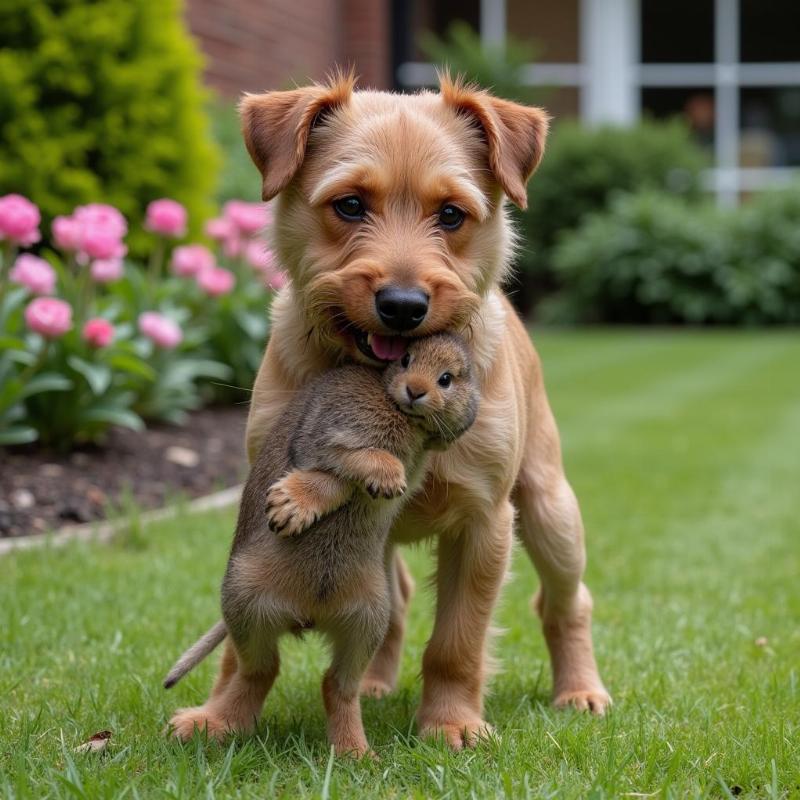Dogs killing rabbits is a common, yet often distressing, occurrence for owners. Understanding the root of this behavior is key to managing it effectively and ensuring the safety of both your dog and the local wildlife. Several factors contribute to this predatory instinct, including genetics, prey drive, and learned behavior. Let’s explore these reasons in detail.
Understanding the Predatory Instinct
Domesticated dogs, despite years of companionship with humans, still retain instincts inherited from their wild ancestors, wolves. This inherent prey drive is a natural response to small, fleeing animals, triggering a chase and kill response. Certain breeds, like Terriers and Hounds, were specifically bred to hunt small game, making their prey drive even stronger. Even seemingly gentle breeds can exhibit this behavior. It’s important to remember it’s not a reflection of aggression towards you, but a natural, albeit sometimes undesirable, instinct.
The Role of Genetics and Breed
Genetics plays a significant role in a dog’s predisposition to hunt rabbits. Terriers, for example, were bred to burrow and flush out small animals like rats and rabbits. Sight hounds like Greyhounds and Whippets, on the other hand, were bred for their speed and keen eyesight, perfect for chasing down fleeing prey. Even if your dog isn’t a traditionally hunting breed, they may still possess the genetic predisposition to chase and kill small animals. This can be influenced by mixed breed heritage or simply individual variations within a breed.
 Dog catching a rabbit
Dog catching a rabbit
Learned Behavior and Reinforcement
Dogs can also learn to kill rabbits through experience. A successful hunt, even accidental, reinforces this behavior. If your dog has caught and killed a rabbit before, they are more likely to repeat the behavior. This is especially true if they receive positive reinforcement, even unintentionally. For example, if your dog brings you a dead rabbit and you react with excitement or praise, they might interpret this as encouragement.
How to Manage Your Dog’s Rabbit-Chasing Behavior
Addressing this behavior requires a multi-faceted approach. Consistent training, environmental management, and understanding your dog’s individual triggers are crucial.
Training Techniques
Positive reinforcement training can redirect your dog’s focus. Teach commands like “leave it” and “come” to interrupt the chase. Reward them for obeying these commands, even when a rabbit is present. Consult a professional dog trainer for personalized guidance.
Environmental Control
Limiting your dog’s access to rabbits is essential. Keep your yard securely fenced and supervise them closely during walks, especially in areas known to have rabbits. Consider using a leash or long line to maintain control.
Understanding Your Dog’s Triggers
Observe your dog’s behavior to identify what specifically triggers their prey drive. Is it the sight of a rabbit, its movement, or its scent? Once you understand the triggers, you can work on desensitizing your dog to them through gradual exposure and positive reinforcement.
Conclusion
While a dog’s instinct to kill rabbits is natural, it’s essential to manage this behavior for the safety of wildlife and your dog’s wellbeing. By understanding the underlying causes – genetics, prey drive, and learned behavior – and implementing appropriate training and management techniques, you can effectively curb this instinct and foster a harmonious relationship between your dog and its environment. Remember, consistency and patience are key.
FAQs
- Why does my dog bring me dead rabbits? This is often a sign of their prey drive and a desire to share their “prize” with you, much like their wolf ancestors would share with their pack.
- Is it cruel to stop my dog from chasing rabbits? No, it’s essential for the safety of the rabbits and your dog. It also prevents your dog from potentially contracting diseases from wild animals.
- Can an older dog still learn to stop chasing rabbits? Yes, with consistent training and management, even older dogs can learn to control their impulses.
- What if my dog ignores my commands when it sees a rabbit? This is common. It means the prey drive is overriding their training. Seek professional help from a certified dog trainer.
- Are there any breeds that are less likely to chase rabbits? While any dog can exhibit prey drive, some breeds, like Cavalier King Charles Spaniels or French Bulldogs, are generally less inclined to chase.
- My dog only chases rabbits in my yard, is that a problem? Yes, it can still be dangerous for the rabbits and reinforces the unwanted behavior.
- Can a dog’s prey drive ever be completely eliminated? It’s difficult to completely eliminate a deeply ingrained instinct, but it can be managed effectively with proper training and environmental control.
Beautdogs.us is your premier resource for all things dog-related in the US. We offer expert advice on dog breeds, care, and training, empowering you to provide the best possible life for your furry friend. Whether you’re a seasoned dog owner or just starting your journey, Beautdogs.us is your trusted companion. Contact us at [email protected] or +1 501-555-7529 for expert guidance and support.